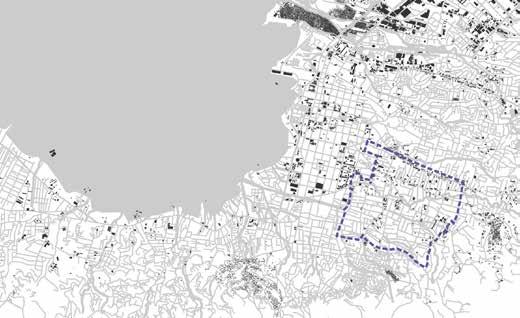
4 minute read
Studio Aims & Scope
Port-au-Prince Bay
Study area within Port-au-Prince.
After striving to meet the immediate needs of survivors and grieving for those who perished during the devastating earthquake that occurred on January 12, 2010, it was possible to take stock of the extent of the destruction. Several historic neighborhoods of Port-au-Prince, including Bois Verna, Pacot, Turgeau, and Bas Peu de Choses, suffered notably less damage than many other parts of the city, and these areas have likewise been remarkably resilient compared to other areas of Port-au-Prince. Their older Gingerbread architecture was not as prone to collapse as more recently constructed buildings, especially those of reinforced concrete. These turn-of-the-century Gingerbread houses are an icon of Haiti’s rich past, characterized by intricate ornamentation and steeply pitched roofs and constructed in timber, masonry, and combinations thereof. Early assessments undertaken after the earthquake found that traditional construction techniques proved seismically resistant, thereby preventing many Gingerbread structures from collapsing. In addition, their connection to Haiti’s history made the survival of this cultural heritage an important beacon for resilience. As Michèle Duvivier Pierre-Louis, Executive Director of FOKAL and former Prime Minister of Haiti, noted:
...saving the Gingerbread houses in Port-au-Prince would represent the conservation of a powerful and unique symbol of urban planning and architecture.... Recently Haiti has gone through political upheaval, periods of violence, and natural disasters that have had devastating effects on every aspect of the country’s historical, cultural, and natural heritage. The Gingerbread houses have not been immune to this overall deterioration. But paradoxically, the situation has at least given us the opportunity to speak out and show once again our unique creativity. In this sense, culture in general remains a factor for social integration, in that it is a uniting force, situating us in terms of our history, our collective memory and the present time. In return, memory and history nourish culture in its infinite variety of expression and show the way forward into the future. Making this cultural wealth the subject of research, creation and education can be hugely beneficial in recreating Haiti’s social fabric. In a country whose developing citizenship is looking for roots, culture can help transform our relationship with ourselves, with others, and with our surroundings. [1]
International assistance and government support for heritage conservation have been extremely limited in the five years since the earthquake, with most aid going to shelter, feed, and care for the many displaced and vulnerable residents of Port-au-Prince. Early post-earthquake efforts sponsored by World Monuments Fund (WMF), the International Council of Monuments and Sites (ICOMOS), the Prince Claus Fund, and the Fondation connaissance et liberté (FOKAL) sought to assess the damage suffered by the Gingerbreads and promote their recovery.
A rapid survey of the Gingerbreads was undertaken in the aforementioned neighborhoods, covering a span of 1+ square miles and ranging in density, form, and fabric. Since 2010, only limited research has been undertaken to document the surviving Gingerbreads, as well as those lost in recent years, and very little is understood about their relationship to their urban context—physically, environmentally, socially, and economically. While FOKAL has spearheaded a program to train artisans in the traditional construction techniques and crafts needed to restore Gingerbread architecture and has been a staunch advocate for preservation, there is still much ground to cover between finding ways to restore an individual building and finding ways to meet larger needs at a neighborhood scale.
Recognizing both the important work that has already been done, as well as the challenges ahead to preserve Haiti’s Gingerbread heritage, Columbia University’s Graduate School of Architecture, Planning, and Preservation (GSAPP) developed an advanced studio course in the Fall of 2015 focused on the Gingerbreads as important elements of the urban environment of Port-au-Prince. Given the value they hold to the people of Haiti, the Gingerbreads are not simply historic buildings in need of repair; they are a form of living heritage that can help to catalyze change within the physical and social fabric of the community. The studio concept developed from this premise.
Drawing students from historic preservation, urban planning, and real estate development, the studio explored three fundamental questions:
1. What can the Gingerbread houses contribute to the surrounding urban context (socially, environmentally, and economically?
2. What can the surrounding urban context contribute to the preservation and valorization of the Gingerbread houses?
3. What challenges do the Gingerbread houses currently face and how might those challenges be overcome?
As an advanced studio, the course was conceived as a facilitated learning experience to engage students in interdisciplinary professional practice and fieldwork. Real-life issues and clients drive such studios at GSAPP. Through independent and collective research, data collection, and analysis, the students shaped the direction of the study and its ultimate proposals, in keeping with the aims and needs of FOKAL, who served as the “client” for didactic purposes. Specific learning objectives included working collaboratively on a client-driven project and report, locating and aggregating relevant data resources, developing rapid survey methods appropriate to a challenging field environment, and mapping and visualization of urban data.
A core element of the studio was a week of intensive field work in Port-au-Prince (October 4–9, 2015). The Columbia students, along with collaborators from Maîtrise en Histoire, Mémoire et Patrimoine at the Université d’Etat, the Université Quisqueya, and the Haitian Education and Leadership Program (HELP), spent the greater part of the week documenting more than 350 Gingerbreads and their urban contexts using an electronic survey to rapidly record information and collect photographs. Upon returning from the field, this material provided the baseline data upon which a geospatial inventory was developed and all conclusions and analyses were based. This report serves to summarize their analyses as well as present proposals for how the Gingerbread houses can be preserved within Port-au-Prince’s diverse urban environment and can create positive benefits for the city’s communities.







